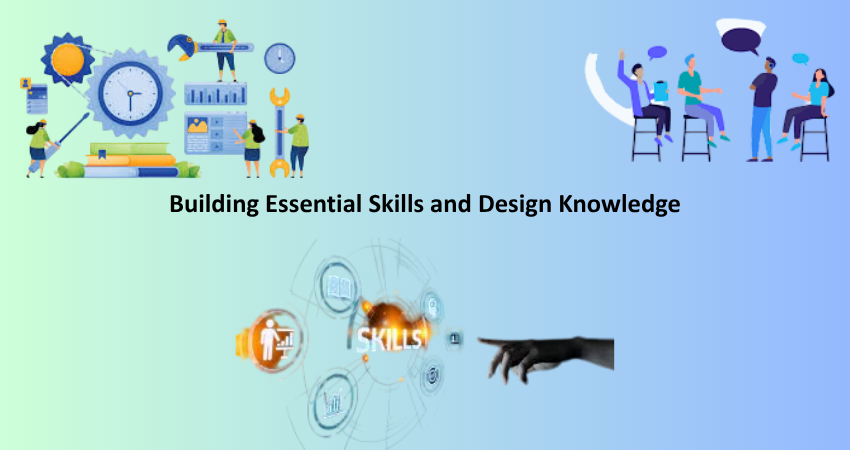
Introduction
In this digital age, UX/UI design is increasingly in demand and impacting careers. Whether your background is in marketing, graphic design, teaching, psychology, engineering, or customer service, finding a transition into UX/UI design is perfectly possible—its becoming even more common. As UX and UI design companies put their highest premiums on empathy, creativity, and problem-solving in the making of user-centered products, those interested in the field will be able to shine. An added advantage: many of the skills learned in other fields can be transferred, contributing to a fulfilling UX/UI career.
If I want to take a professional shift, there are a lot of things that keep telling me not to take that leap. You immediately think about the age that will stop you from changing professions; educational qualifications will put you in touch with all the degrees they will require for this change. As for the reality, there are diversities into the UX/UI field: background diversity into thought and experience diversity thrives there. These professionals are the most successful, while those that have been trained in design or traditional ones may not always be the ones scoring it big with their designs. Here in this article, you will find each transform on how one can learn to switch into the UX/UI designing field, including skills needed, getting experiences or knowledge to leverage, portfolio construction from ground zero, and positioning in a competitive market.
Understanding the Fundamentals of UX/UI Design
What Is UX/UI Design and Why Does It Matter?
Before embarking on a career in UX/UI design, it is necessary to discern what the practice is about. User experience (UX) design is defined as the research of the interaction between users and a product or system. This includes research, information architecture, usability testing, wireframing, and interaction design. Comparatively, user interface (UI) design handles the visual and interactive components of a digital product, specifically buttons, typography, spacing, and color scheme. UX focuses on functionality and flow, while UI aims to embellish and beautify the entire process. Therefore, UX and UI serve to provide the end user with the smoothest, most engaging experience possible.
The importance of UX/UI can never be stressed enough. Bad designs frustrate users, who dump the app and revenue goes down the drain. A good interface works with usability, customer satisfaction, and brand loyalty. With ever-so-climbing user expectations, companies require designers who think from the users’ point of view. As a career changer, this user-centered mindset is your first step. If you are designing a mobile application, web page, or software platform, your job is solving real-world problems through good design. Empathy, organization, and expression of ideas will always far exceed the latest tool in value; tools, of course, are important, and we shall elaborate on that later.
Identifying Which UX/UI Roles Fit Your Background
It probably could have been said better. UX/UI design is open to a wide range of roles and specializations, and it doesn’t mean that every position within the whole field has the same prerequisites. UI design is a part of this subject, intuitive for those from a graphic design background or perhaps from other specializations. To those with a primary research focus—like psychology, anthropology, or marketing—would probably make the strong fit for UX research or UX strategy roles. Teaching and customer service experience can help one do very well with UX writing or interaction design because of knowing how to guide, inform, and empathize with end users.
The understanding of previous experience overlap with design dictates the path chosen. Identify transferable skills: Are you good at visualizing ideas or explaining complex concepts? Do you have experience interviewing users or analyzing feedback? Are you detailed or systems-oriented? For example, project managers often make great UX designers because they know how to prioritize tasks, gather requirements, and work cross-functionally. Start to assess how those existing strengths of yours translate into UX/UI responsibilities; this will help you decide where to focus on your learning and start developing your portfolio in a way that honors not only your past experience but also puts you on the path towards your future career ambitions.
Building Essential Skills and Design Knowledge

Learning the Core Principles of UX and UI Design
Once you have made the decision to choose a transition for yourself, the next set of activities should be to develop your set of foundational skills. The first step would be learning about principles of UX, which include usability, accessibility, user-centered design, and interaction flow. Learn about user research, persona building, user flows, and prototype testing. UX is the solving of problems; hence, you need a healthy dose of analytical and inquisitive thinking. The best way to learn is with experience: Pick a simple app or website and critique its design. How easy is it to use? Where does it confuse the user? What can be improved?
Apart from UI, you should try to develop skills in layout, typography, color theory, and visual hierarchy. UI design concerns itself with aesthetics as well as function, so the key concepts to master are equilibrium, consistency, and contrast. There are loads of resources available online, from books (like Don’t Make Me Think by Steve Krug) to free classes on Coursera, YouTube, and Figma’s Learn Hub. Adobe XD, Sketch, and Figma are the main industry tools, so you must at least get onboard with one. Consider setting up a mock project to apply what you are learning. When you begin to understand the why behind your design decisions, you will develop from a novice into a purposeful practitioner.
Choosing the Right Learning Resources and Courses
If you desperately want to become a UX/UI design professional, there are tons of learning materials on the internet. Sadly, not all are good for you; some of the boot camps and courses you want to attend give more weight to keeping current with the tools than to developing critical thinking skills, while others may barely touch upon all aspects of visual design. Your time and money are important commodities; go for the choices that balance theory and practice. The Interaction Design Foundation (IDF), CareerFoundry, and Springboard provide customized learning paths with mentoring and projects from real life. The same goes for free materials: for example, Google’s UX Design Certificate and tutorials from DesignCourse will also get you started.
When you want to start the resource for using hands-on assignments, portfolio development, and constructive feedback. UX/UI could be a better domain to learn because work and portfolios do more talking than a resume ever would. Community Discord servers, Slack groups, or forums: find one in which you can ask questions and engage with others to motivate yourself. The peer review becomes imperative because it mimics the kind of collaboration that you’ll find in any workplace. Make a habit of learning consistently. Reading, sketching, or prototyping at least for just 1 or 2 hours a day could create an accumulation over time. Over time, you will want to go back and return to the previous works to reflect on how you’ve grown and the refinement of the process.
Gaining Practical Experience and Building a Portfolio
Working on Personal Projects to Demonstrate Your Skills
The so-called ‘chicken-and-egg’ problem represents one of the largest hurdles facing career changers in their path to employment: competent employers are looking for considerable experience, but how on earth could an individual gain that experience without ever being employed? The answer to such a dilemma lies in personal projects, basically self-initiated case studies that highlight the methods of solving design problems. Redesign a website for a nonprofit organization, revamp an ordering experience for a local coffee shop, or develop an onboarding flow for an imaginary application. Take the entire process of UX through each step: research, ideation, wireframing, prototyping, and testing. Document clearly and methodically along the way. These personal projects improve skills as well as providing more tangible proof of your skills.
Storytelling is the essence of a successful personal project. Do not merely present aesthetically pleasing screens; narrate your thought process. What was the problem at hand? Who were the users? What constraints did you have? What decisions did you take, and why? A truly well-structured case study often outweighs real-world experience, for it indicates drive, problem-solving, and communication skills. Whenever possible, look to make each project different—solve different kinds of problems so that your portfolio appeals to a variety of potential employers or clients. As you gather more projects, you will start to formulate your very own repeatable, reflective, and distinct design process.
Contributing to Open Source and Freelance Projects
Real-life experiences can also be gained through contribution to open-source projects or offering services to small businesses, startups, or non-profits. Open-source projects often include design-related issues on GitHub. Catchafire and Taproot even allows anyone in need to volunteer their design skills for a cause. Certainly, it also fills up that portfolio but teaches you how to work with the developers, product managers, and stakeholders, which is a key ingredient in the work of UX/UI.
If you want to consider nurturing your vocational path, you could employ yourself by going freelance at paltry rates. Although the freelance market may not promise the highest monetary rewards by any stretch of the imagination, platforms such as Upwork, Fiverr, and Contra will let you practice scoping work, managing feedback, and design delivery within deadlines. Be it pro bono or a friend’s project, be professional at all times. Such cases can later become cornerstone case studies addressing your credibility? Gradually, when you attain confidence and skills, you fairly well may wish to then charge higher fees or else walk into full-blown UX/UI work. The objective thereby becomes to get away from theoretical learning and into solving real-world problems, thereby creating a need for you to step into discomfort and out into some real-life situations.
Positioning Yourself for the Job Market

Tailoring Your Resume and Story for UX/UI Roles
As a career changer, your new resume will hardly resemble a designer’s standard fare, and that is perfectly fine. The main aspect to focus on is highlighting transferable skills and configuring your story to match employers’ needs. An excellent summary should talk about your true love for design, mention past experience, and describe your career objective. Be able to draw on your work experience to emphasize abilities like research, teamwork, communication, and problem-solving, or use of digital tools. Don’t use vague adjectives; instead, use specific terms that describe outcomes and responsibilities in prior jobs.
Moreover, tailor each resume for each application. If you are applying for a UX researcher position, focus on your skills for data analysis, surveys, or interviews; if it is UI design, focus on visual tools, creative projects, and typography. Put your portfolio link prominently at the top, and all your website and case study pages should look really good and easy to navigate. Give a convincing explanation of your decision to change careers—why you are changing, what you have learned, and how your past experiences have made you a stronger designer. This will be asked during interviews, so be prepared to tell it well and with confidence.
Navigating Job Applications and Networking as a Career Changer
Breaking into UX/UI from another sector can seem dreadfully intimidating. Yet, by following a planned approach, your chances of landing interviews will be enhanced. Do not apply just on job boards; instead, look for designers, hiring managers, or recruiters on LinkedIn. Inquire about setting up an informational interview with them to gain their perspective on their career path and share your own. Many of the advertised positions are not. Networking can open doors that applications never could. Joining some design communities online or attending local meetups and webinars will help in expanding relationships and staying abreast with opportunities.
Apply for entry-level positions, junior roles, internships, and apprenticeships-even if you are currently in mid-career in your field. Some companies also have returnships or career change programs for people trying to transit into tech. Tailor every application to the specific company, its missions, products, and design esthetic. Continue to refine your portfolio based on feedback and consider each rejection an opportunity to polish your pitch. With perseverance, continued learning, and proficient storytelling, career changers will win UX/UI jobs and thrive in those roles.
Conclusion
A successful and rewarding path is open to individuals wanting to switch their careers into UX/UI design. With such diversity in perspectives, UX/UI would benefit from your past career whether in teaching, writing, customer service, development, or management. The most important thing is to have a good grasp of design basics, determine your transferable skills, keep yourself open to continual learning, and apply your skills through either personal or real-world projects.
Documenting your portfolio means that you will be able to mix design thinking with the experience of your own background, offering you scope for strategic positioning within the job market. Thus, you can transition gracefully into a career that allows you to be creative and makes an impact while offering the possibility of future growth. Career transitions require the power, but design professionals can be empathetic, curious, and well to grow in UX. So first, step forward and embrace the learning curve. Begin developing for your future a meaningful and rewarding way in UX/UI design.